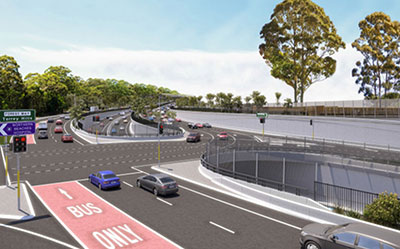Community and Environment - Northern Beaches Hospital
Project overview
Community feedback was integral to the development and delivery of the Northern Beaches Hospital road upgrade project. Engagement with the community, businesses and other stakeholders has been ongoing since March 2014.

Some documents on this page may not comply with accessibility requirements (WCAG).
If you are having trouble accessing information in these documents, please contact us.
Community information
Community consultations
Community feedback has been integral to the development and construction of the Northern Beaches Hospital road upgrade project.
Engagement with the community, businesses and other stakeholders has been ongoing since March 2014.
 Nearly 20,000 community members have been consulted as part of this process. Environmental Impact Statements were placed on public display in 2014 and 2015, and the community were invited to provide submissions on the project. All feedback received was carefully considered and we have been able to make several improvements to the project based on the feedback received. You can view the submissions report from the project documents page.
Nearly 20,000 community members have been consulted as part of this process. Environmental Impact Statements were placed on public display in 2014 and 2015, and the community were invited to provide submissions on the project. All feedback received was carefully considered and we have been able to make several improvements to the project based on the feedback received. You can view the submissions report from the project documents page.
We thank the community for its participation in this process.
The community was also invited to comment on the draft Urban Design and Landscape Plan (UDLP) report which outlines details and designs for the road project, underpass, pedestrian bridges and paths, landscaping and vegetation, noise wall, and road furniture (lighting, signage, shelters). The report was displayed in mid-2016 and included drop in sessions for residents and a community update distributed. Nearly ninety submissions were received. All feedback was considered and the final UDLP report was submitted to the Department of Planning and Environment and approved.
Community engagement
Community engagement continued throughout construction with over 30,000 interactions recorded with stakeholders, local residents and the community.
Engagement activities included door knocking, letterbox drops, email updates, community information sessions, meetings, work notifications, forums, information stalls, the project’s interactive portal and one-on-one in person and telephone conversations with the community. The project team met regularly with key stakeholders including Northern Beaches Council, emergency services, local schools, businesses, community groups and residents.
Urban design
Roads and Maritime aims to deliver a project that is physically and visually integrated with its surrounding environment, enhances community connectivity and engages the road user with the unique and defining characteristics of the local context.
To achieve this, Ferrovial York Joint Venture prepared an Urban Design and Landscape Plan (UDLP) report which outlines details and designs for the road project, underpass, pedestrian bridges and paths, landscaping and vegetation, noise wall, and road furniture (lighting, signage, shelters).
with its surrounding environment. It enhances community connectivity and engages the road user with the unique and defining characteristics of the local context.
Ferrovial York Joint Venture achieved this by prepared an Urban Design and Landscape Plan (UDLP) report that outlined details and designs for the road project, underpass, pedestrian bridges and paths, landscaping and vegetation, noise wall, and road furniture (lighting, signage, shelters).
A draft version of the UDLP report was available for community comment in June 2016. All feedback was considered and the final UDLP report was submitted to the Department of Planning and Environment and approved.

Artists impression: View along Warringah Road at Forest Way intersection
Environmental impact statements
The impacts of the project were examined thoroughly in the Environmental Impact Statements (EIS). These documents, available to view or download from the project documents page, provide details of expected impacts and outline measures to manage and mitigate these impacts.
These impacts include environment, noise, vibration, biodiversity, land use, heritage, air quality, flora and fauna.
The project team also commissioned a Wildlife Connectivity and Road Risk Minimisation Strategy (PDF, 3.12Mb) to demonstrate how habitat connectivity will be maintained or enhanced during and after construction of the project
Protecting local fauna
Many species of fauna are found within the area, including mammals, birds, reptiles and amphibians. As part of the EIS, extensive studies have assessed the potential impact of the project on these fauna and outlined measures to avoid or minimise any impacts.
The project ecologist is regularly on site to ensure best practice during clearing
to minimise any harm to flora and fauna. If animals are found during clearing, work stops and the animal relocated to a suitable habitat within the local area. Before clearing, an ecologist identifies any hollow bearing trees and helps determine suitable locations for the installation of nest boxes.
To ensure fauna can safely access vegetation on either side of the upgrade, rope bridges and culvert crossings will be included where appropriate, with input from ecological specialists.
Fauna fencing would be used to minimise the possibility of vehicle strikes once road construction has been completed.
For more information, please view or download the Flora and Fauna Fact Sheet.
